(continued from Full Transparency)
Around this time, I purchased the new edition of Jack Schwager’s Market Wizards, now titled Hedge Fund Wizards. My pal Coulsen told me to skip to the end and read the best chapter: “Stepping in Front of Freight Trains.” It featured the only prop trader (from First New York Securities) in the whole Market Wizards series. Here’s the intro paragraph:
Jimmy Balodimas breaks all the rules. He sells into uptrends and buys into downtrends. He adds to losers and cuts his winners short. He is a predominant short in a market that is up the majority of days. By any of the standard guidelines for trading success, Balodimas shouldn’t survive in the markets, let alone thrive. Yet he is one of the most successful traders at First New York Securities, the prop trading firm at which he began his career 15 years ago, and he has never had a losing year.
Oh and he loved to short CMG (Chipotle). Why? Because… They sell tacos!1His words from the interview: “…knowing it’s Chipotle. They sell tacos! It’s not like it’s some new technology company. I’m not going to be that scared of it. The tacos may be really good, but the stock has gone from $140 to $270 in three months. Really? I don’t care how good the tacos are.” Not microchips. Not the cure to cancer. Not electric cars. Tacos. It’s dumb and reductionist but who can argue with a trader who prints money?
I’d think about this chapter all the time. Here was this quad-2 pain sponge who disregarded all the cliches about successful trading and just did what he wanted (and did it well). It’s not that we wanted to emulate his exact style but we were fascinated by his defiance of the trading orthodox. It was said in our training materials that you can’t make a career fading trends (the “hard money”, it was called) or doubling down on losers. This guy’s existence and his 15 year track record proved otherwise.
Every trading desk has wildly varying but often archetypal personality types and this Balodimas guy was definitely a type you’ll find. Remember when I said MBC hired a bunch of ringers when the Joint Venture started? One of them, Hanzo, was a long time colleague of Avery and Victor, dating all the way back to their days at Datek. He too, liked to fade everything.
The Ten Traders You’ll Meet on a Prop Desk
1. The Contrarian — Hanzo
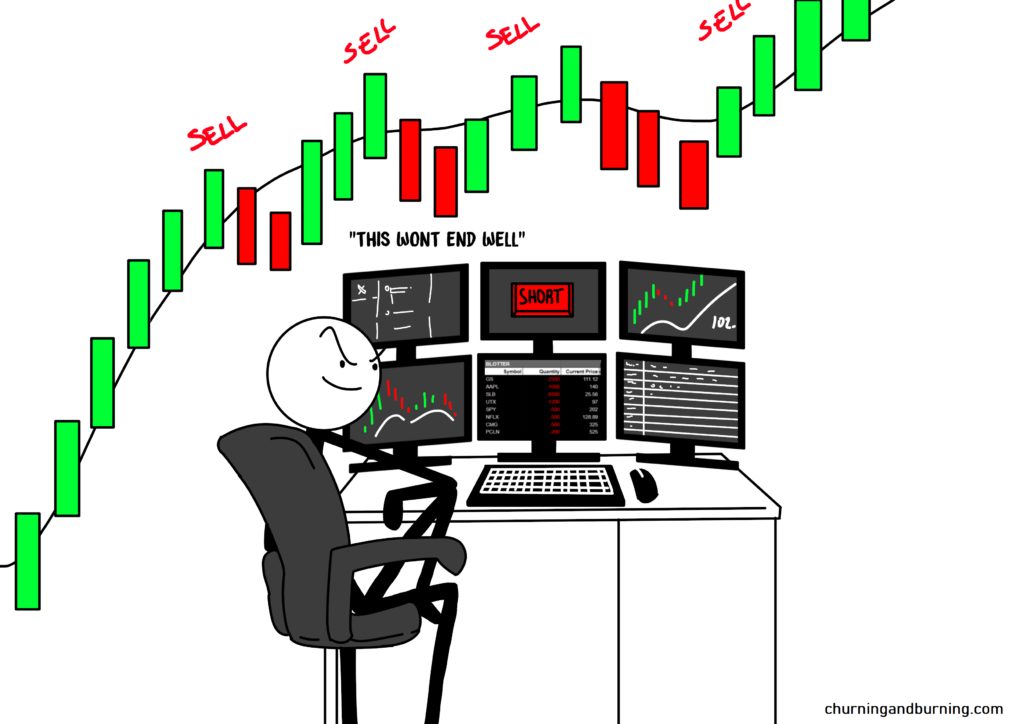
Hanzo’s daily modus operandi was to run an 80%+ short book full of market leading names like PCLN, FB, AAPL, AMZN, TSLA and… CMG. They sell tacos! became our own little rallying cry whenever we saw Hanzo shorting more CMG. He would ride CMG short for 300 points against him and we all thought this was a sign of his incredible conviction. Hanzo always traded countertrend, believing that the turn was right around the corner. He would tout his beloved DeMark indicator, which always seemed to be pointing towards the The Big Market Crash™.
Whatever the market is doing, bet on the opposite–that’s the Contrarian mantra. Every single prop firm you’ll join has at least one. A close cousin of The Contrarian is The Doomer. The Doomer will swear on the fact that (insert sitting president here)’s America is going to hell, we went up “too far & too fast”, and it’s all because the Fed and the PPT are falsely propping up the market. They’ll spam the group e-mail with 1929 analog charts, videos about Weimar Republic, and Bloomberg articles of Michael Burry’s “$1.6 billion bet against the market”2this is notional value for options, a totally meaningless number that doesn’t represent his portfolio risk . They’re insufferable. To Hanzo’s credit, he seemed like a pleasant guy who would spare us the doomer propaganda. We all liked him. He was more likely to talk to you about his son’s golf game or his travels in Korea. He made us actually root for the big crash.3That and because we all wanted our chance to be hero buyers in a big crash just like all the top traders at WTG
Even though the market went against him, Hanzo could trade around his positions well enough to reset some of his prices, which is a sign of decent skill. A contrarian without the trading chops probably would’ve been fired quickly but Hanzo managed to stay above water and stick around. Nonetheless, we always wondered… would Hanzo ever catch the big move? Would he change his mind? Would there ever be a bridge too far in a runaway bull market that would turn off his lights? Permanent contrarianism is a tough way to trade. We never saw The Big Market Crash™ that Hanzo’s DeMark indicator had promised.
2. The Spazz — Laser
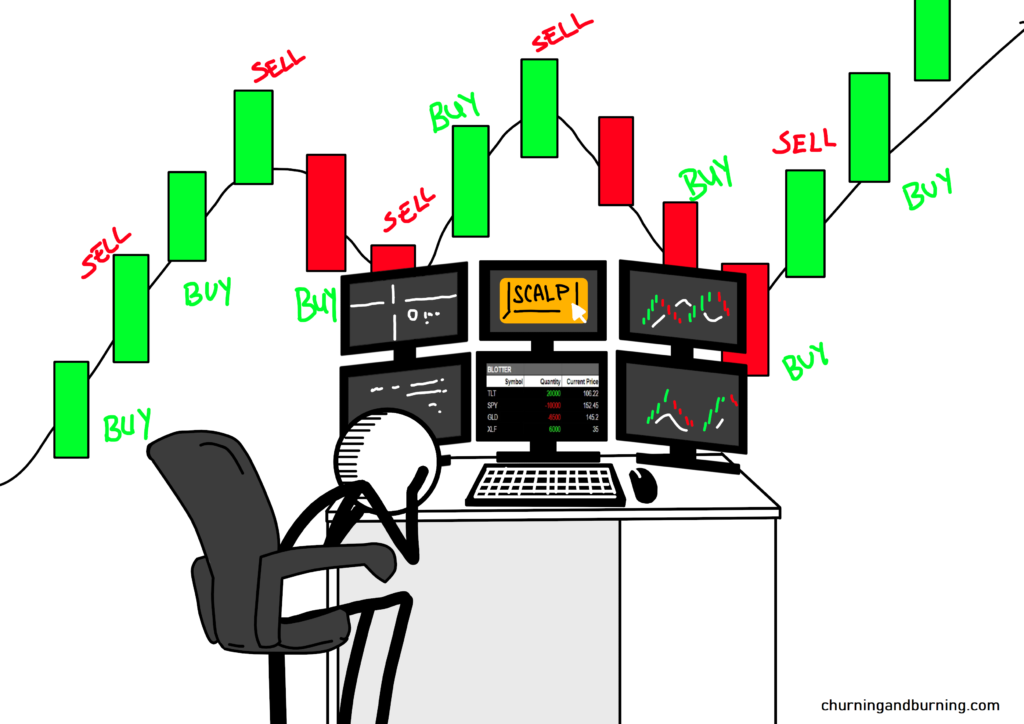
Laser traded at the Austin main branch but he had an NYC prop background dating back to the late 1990’s4this actually sorta explains why he trades hyper-actively rather than more similar in style to the Austin-grown traders. I never met him in person but I feel like I knew Laser just through the TIX Window, as I’d see him overtrade the shit out of everything with crazy size. Breaking news and sudden price spikes would draw him in like a moth to a flame.
At MBC, we were kind of picky about our price location. Consolidation, breakout, and trend was the mental model we followed and we didn’t want entries too far away from the base (consolidation). No one wanted to be the guy who paid the highs or hit the lows to initiate a position. Then you had Laser, who had no qualms about getting in ANYWHERE and with size. He just didn’t give a fuck. Stock has a 5 point spike in 30 seconds and there are no levels to keep risk tight? Book is way too thin? Laser’s recklessly clearing the offer with 20,000 shares. Then he’d be out in 10 seconds. Then he’d be in again. Then he’d be out again. Then in. Then out. In. Out. Then he’d flip short.
I couldn’t discern the rhyme or reason to most of his trades, as they often appeared random and impulsive. Every prop firm has a Spazz clicking in and out all day and you wonder if it’s a sign of debilitating gambling addiction. Laser actually made money but he only netted about 10% of his gross profits, by far the least efficient trader at the firm 5efficiency was a firm statistic that captured how much of your gross profits converted into net profits after fees. I can only imagine him at 4pm… completely out of mental capacity and staring lifelessly at the level II, fluids slowly leaking out of his brain.
3. The Whale — Mr. West
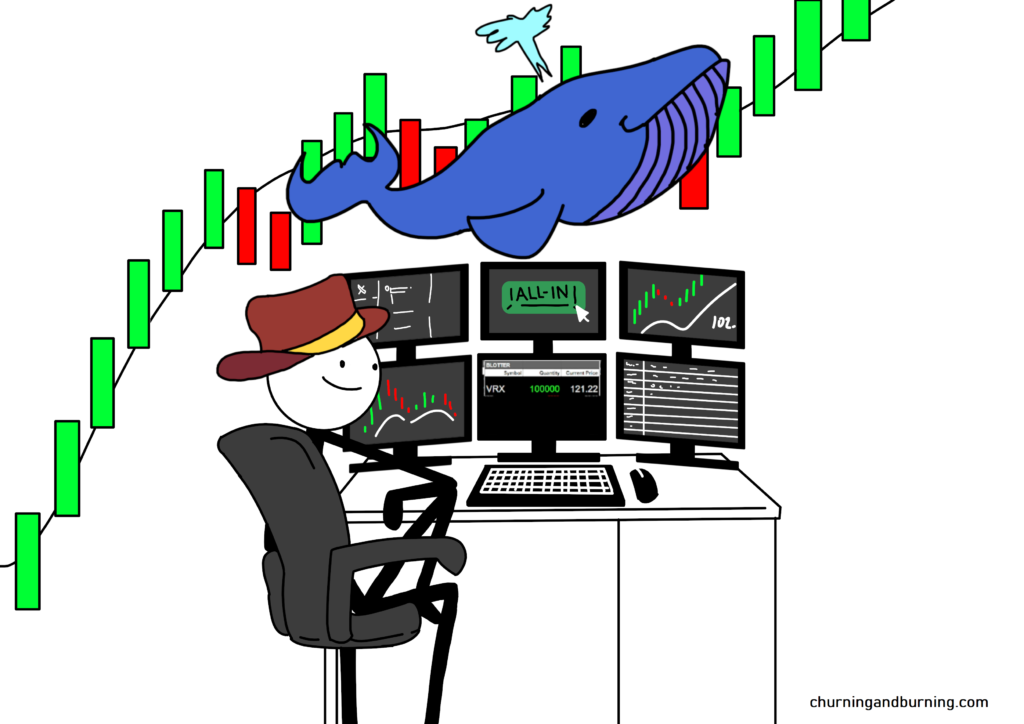
The Whale is usually the guy that everyone else at the firm is always talking about because he swings the most money, like Spark Merling at Y5. We love to be railbirds for the biggest traders and to gawk at their huge wins and losses–it’s why “PnL Porn” often gets the most eyeballs online. Mr. West wanted to promote his firm’s radical transparency so he would add anyone who requested him on the blotter. In many ways WTG’s risk taker culture was a reflection of his own massive risk tolerance.
Mr. West states that his best ability is to take pain and that big numbers don’t bother him. He’s a classic quad 2 trader (high risk/swing timeframe). The Whale can’t feel alive without a massive bet at risk.
There was this time hedge fund darling VRX (Valeant Pharma, now BHC) tanked and had Mr. West fishing for the bottom. 6VRX was a great battleground story with a lot of big players like Bill Ackman, Sequoia Fund, Jeff Ubben being long and then smaller traders/funds like Andrew Left and Fahmi Quadir being short on the thesis that VRX had committed some fraud. Watch the Netflix documentary Dirty Money if you want to know more He bought a huge amount of shares at $120, only to watch it go to $88 and be stuck more than $3 million. At the dead low, VRX halted for a “positive news announcement” and then re-opened for a huge bounce back to $128. I call this the lucky parachute. Now… us rational folk might just do the sensible thing and take our lucky parachute–we’ll lighten up or sell entirely into the bounce at break even or marginal gain. Maybe just re-evaluate the situation later when there’s more clarity. How can anyone sleep at night with millions on the line on a potential fraudulent stock? Not Mr. West, he held it all.
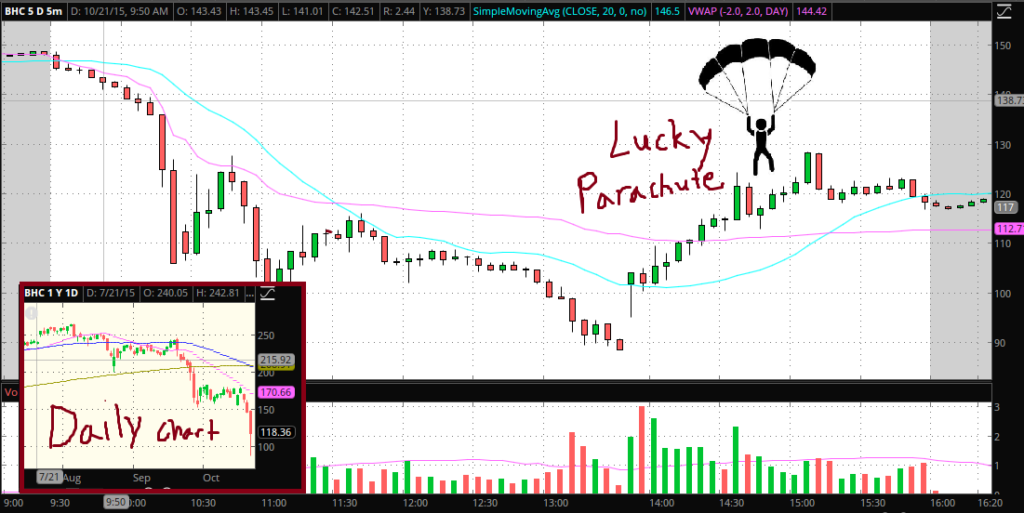
It didn’t end well. Mr. West ended up taking a $6 million dollar loss several days later as Valent management were unable to convincingly defend against the accusations. VRX reached a low of 73 before year’s end and then eventually went to single digits.
It’s always tempting for a new trader to think they can just follow The Whale. He must know something. He must know it will eventually turn around. But the simpler, harder truth is that nobody knows anything. Mr. West took far more pain than anyone and would routinely draw down obscene amounts. It’ll go the other way when he finds himself on the right side of the trade and he’ll make it back but 99.9% of traders couldn’t handle his PnL swings. New traders should never try to follow The Whale indiscriminately.
I finally met Mr. West during a corporate happy hour when WTG’s management traveled out to NYC. Mr. West already knew our names, probably after asking Victor who MBC’s best young traders were. He had a super approachable vibe–the gregarious businessman with a soft Texan drawl. We had a heartfelt conversation about risk and I asked him: How was he able to hold huge these positions and think big picture and not shit himself? What’s his secret?
His answer: “I just compartmentalize.“
4. The Poker Player — Heath Wilson
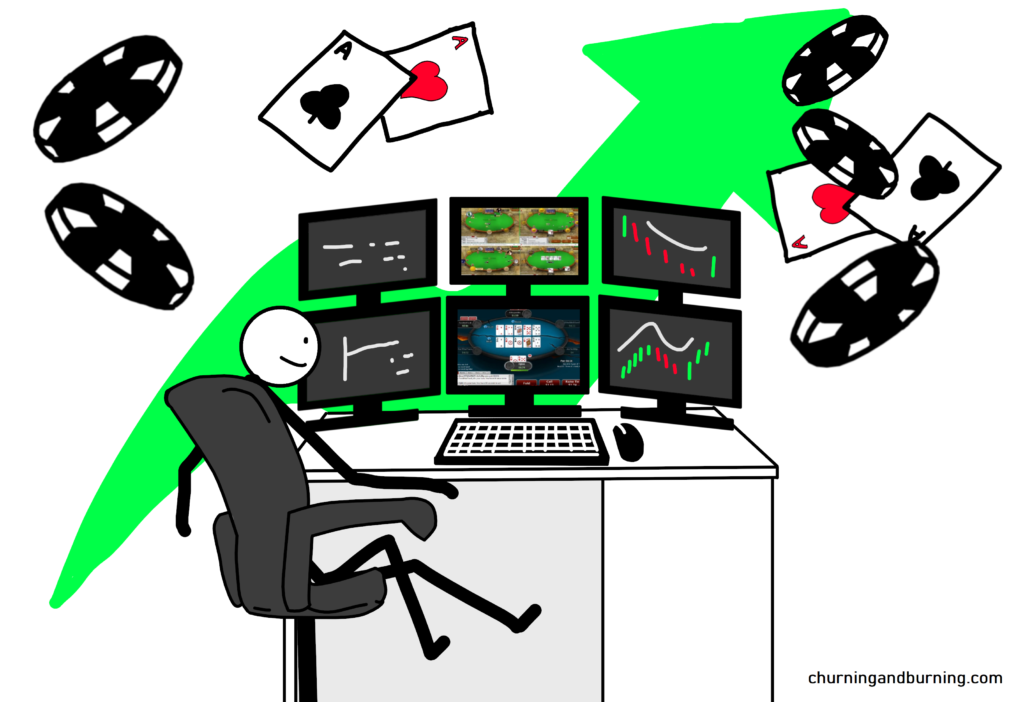
There’s been a lot of notable crossovers between trading and poker over the last few decades, with many known industry guys including poker as part of their origin story. Jeff Yass started SIG partially from poker winnings in the 1980s. Then he hired Bill Chen, who wrote The Mathematics of Poker. Aaron Brown, Chief Risk Officer of AQR, started his career in professional poker. Poker players deal with probabilities and think in bets, two essentials for successful trading. Poker players can also be total degenerates prone to risk management failures. Bright Trading hired high stakes pro Brandon Adams in 2008 and he lost millions betting on biotech clinical results.
Several traders at MBC, myself included, could lay claim to some success at smaller stakes. But Heath didn’t do small-time kiddy pool play… he played real high stakes. He then switched to equities trading full-time and became WTG’s top trader in manual PnL in 2013. His primary strategy was to trade off his own mathematical fair-value pricing model and take advantage of dislocation away from “fair price” during the opening imbalance period.
Several years later, I’d see Heath’s name while looking up World Series of Poker results. He beat Daniel Negreanu heads-up in a $100k high roller event to win his first WSOP bracelet and collect $2.7 million.
5. The Global Macro Guy — Rowboat
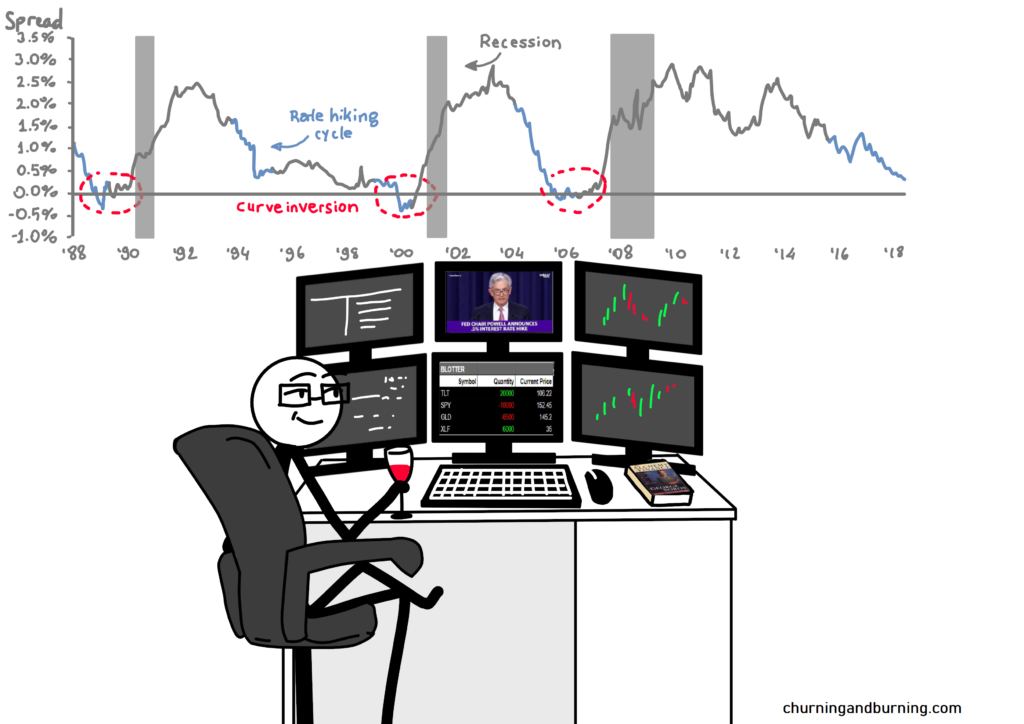
Most day trading firms had simple, unsophtisticated strategies. “I bought because it went up” is basically momentum in a nutshell. You don’t really need to write an essay about your trade ideas. When the electronic age started in the 1990s, the quintessential daytrader was a guy from Long Island with a city college degree.
On the other end of that spectrum, you had Global Macro guys like Rowboat. Rowboat was a bloke from the U.K. with an enviable background: blue-blood boarding school77 prime ministers went to the boarding school Rowboat did, including Churchill, prestige university, 5+ years in bulge bracket, and then hedge fund trader. Macro Guys talk about big picture stuff: Historical asset relationships with interest rates. Central banking hiking and easing. Politics and international trade. Debt crisis, currency crisis, housing crisis, energy crisis, toilet paper crisis. They might use the word “reflexivity” a lot. They’ll passionately spin everything they know into into some grand cause-and-effect theory that sounds smart but they’re just talking up their book. Global macro is actually really hard–for example, Peter Thiel, with all his connections and unlimited resources, couldn’t win at that game. Rowboat, posh background and all, finished the year in a -$228,000 hole, dead last among 100+ traders at WTG and MBC.
Interestingly enough, it was around this time that I noticed Rowboat and Tuco were getting pretty close. They’d talk about and share ideas. Tuco started trading the “big markets” rather than MBC’s stocks with news flow. He’d short GLD and GDX all the time because this around the spot gold bubble had burst. He’d trade a lot of SPY options. He completely pivoted away from “tight-risk” daytrading strategies in favor of macro-driven position trading, with mostly inconsistent results. He told me he had a lot of arguments with Victor and Avery, as they wanted him to “wait for confirmation levels” while he didn’t mind taking more pain and averaging in.
6. The Glitch Hunter — Riggs
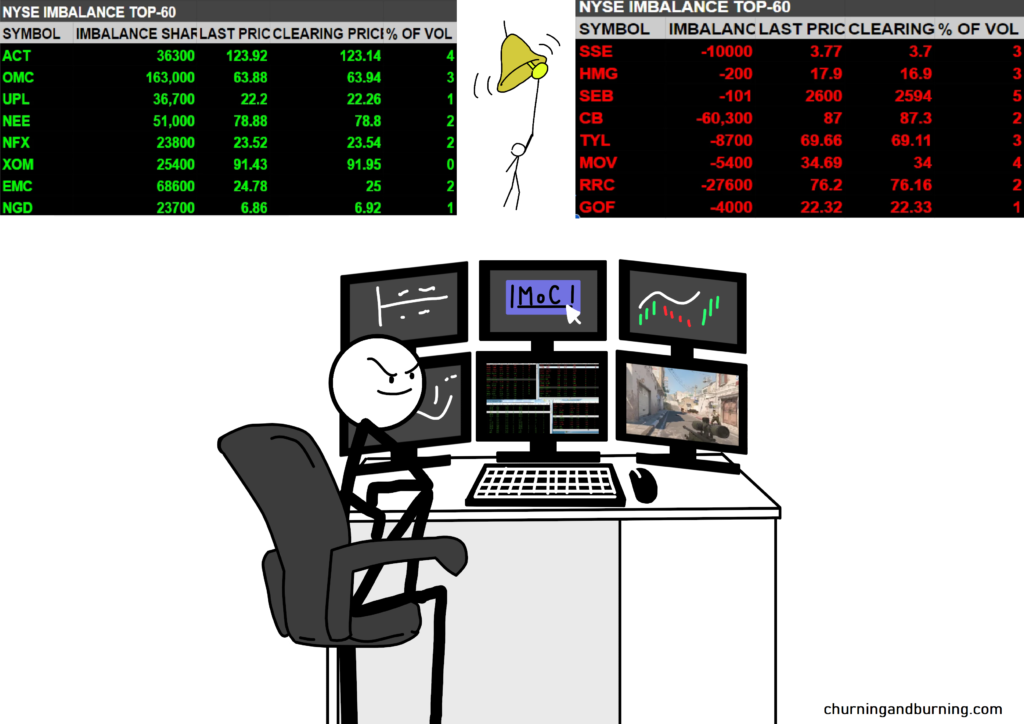
Price dislocation, special situations, arbitrage, auction strategies (imbalances). The best WTG traders were the Glitch Hunters who excelled at trading at least one of those four categories.8I would highly recommend David Hale’s “Cash Rules” for supplementary reading on the subject. He traded in the Austin, Texas scene for over a decade. It required more outside-the-box thinking versus directional trading, where a trader has to guess where the market is going.
These trading strategies might seem like secrets that no profitable trader should be talking about. And there were definitely good traders at WTG who wanted to hide everything they did. But Riggs actually gave us a real-time look at what he did. And let me tell you this: just because you know or see “the secret”, doesn’t mean you can execute it yourself.
We were all super hyped for the Russell 3000 Re-balancing date on June 28th. We were told these days were the most profitable for everyone, that WTG makes millions on these days. There was no formal training program on imbalance trading, all we were given were a few loose guidelines like: “look for an imbalance large relative to the average daily volume” and “bet in the direction of the imbalance for closing print” (buy the net buys, sell the net sells). Then we would enter a customized “flip stop” for each position, which would trigger a stop once an imbalance flipped from net buys to net sells (or vice versa). Anything that doesn’t “flip” is executed at market on close (MoC).
So 3:45 hits and the NYSE imbalance filters start to fill in.
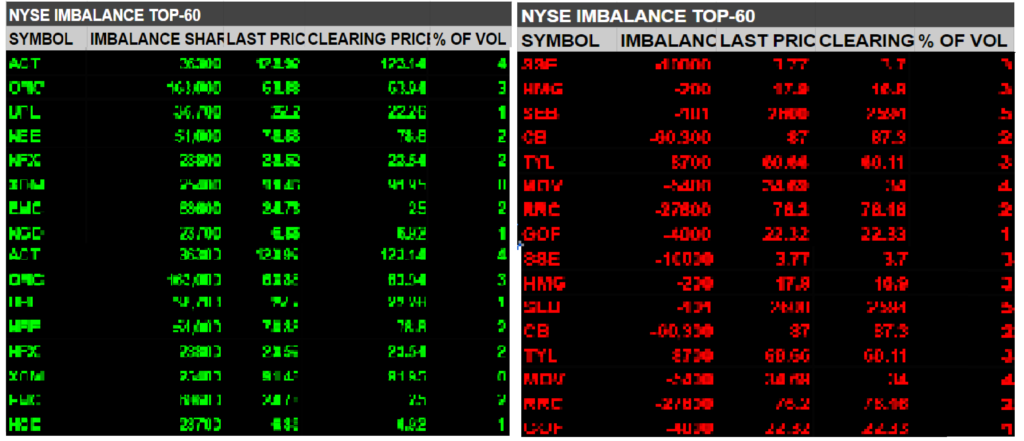
That’s what everything looks like to me… and I realize I don’t have the first clue what I’m doing. The TIX window explodes with executions from anyone trading the re-balance. Riggs is already in 15 positions before I even take my first one.
So I figure, why don’t I just try to copy Riggs real time executions in the TIX Window? He’s the experienced pro who’s been doing this for a long time. I try my best to mirror his positions. Clockwork and Eagle and Mesut get into some positions because of volume??? I don’t know. Maybe they’re just guessing. So am I. I’m totally clicking buttons.
By 4:00pm, 98% of all positions print. Riggs must’ve unwinded at least 70 different positions. The TIX window just spams all of his wins as this occurs. $2k here. $500 here. $200 there. $3k there. Some prints occur as late at 4:05 and those are the sickest prints that required the specialist finding more shares to pair out the imbalance. $8k wins. $10k wins. Me, I had about 25 positions and uh… it seemed like I either picked all the shitty ones or I got in too late. At the end of the day, the blotter looked like this:

I might’ve been the only one who actually lost money. I even got stuck with a couple positions that I had to manually unwind because I didn’t properly execute the MoC order. I felt like a total loser while everyone else was able to positively experience the rush of the Russell Re-Balancing.
There’s always an information gap when you try to emulate a top trader–what they know, how much of that they can communicate to you, and how much of it you can understand (and then functionally execute it). I didn’t understand enough to win.
7. The Quant — Clayton
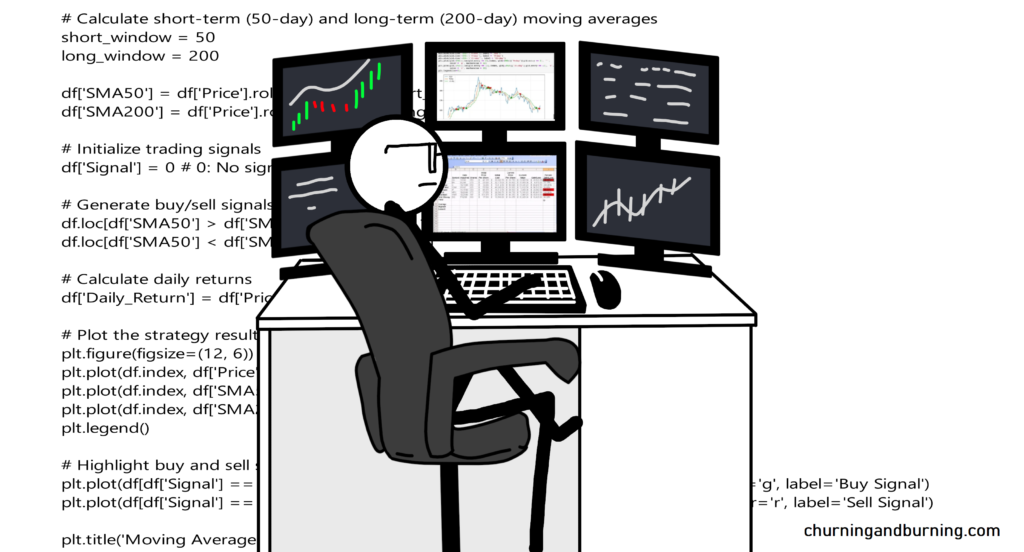
10 years ago, automation was the next big thing. WTG created a backtesting platform called Pr0Pie that didn’t require coding ability. That was the vision for Mr. West and Victor—elite manual traders would use their elite pattern recognition abilities and convert them into profitable algorithms or grey boxes (automatic signals that would be manually traded).
In practice, we only tested what we knew. We’d try to code for chart patterns like bull flag over VWAP or tape situations we could scalp, like large bid at whole number. As you could expect, most of that didn’t go anywhere. I spent a ton of weekend hours trying to backtest weird half-cocked ideas but I didn’t see the results to pursue them any further. I also spent a ton of time on Pr0Pie pulling historical data on imbalances to try to crack that code.
There was one guy in Austin, Clayton, who specialized in automation. He was a losing trader until strictly dedicating himself to automated trading. His strategy was somewhat similar to Heath’s, he had a model that would find price dislocation during the closing imbalance on AMEX stocks. The only difference was that Clayton executed on automation while Heath still executed manually. Some people just have that Quant DNA and it’s just about A) finding your edge and B) having the right tools and infrastructure to succeed.
A good rule of thumb on whether you are meant to be a Quant, is whether you like stats and excel more than looking at a chart or tape and clicking the button.
8. The Guy Who Trades Once A Month — Soup
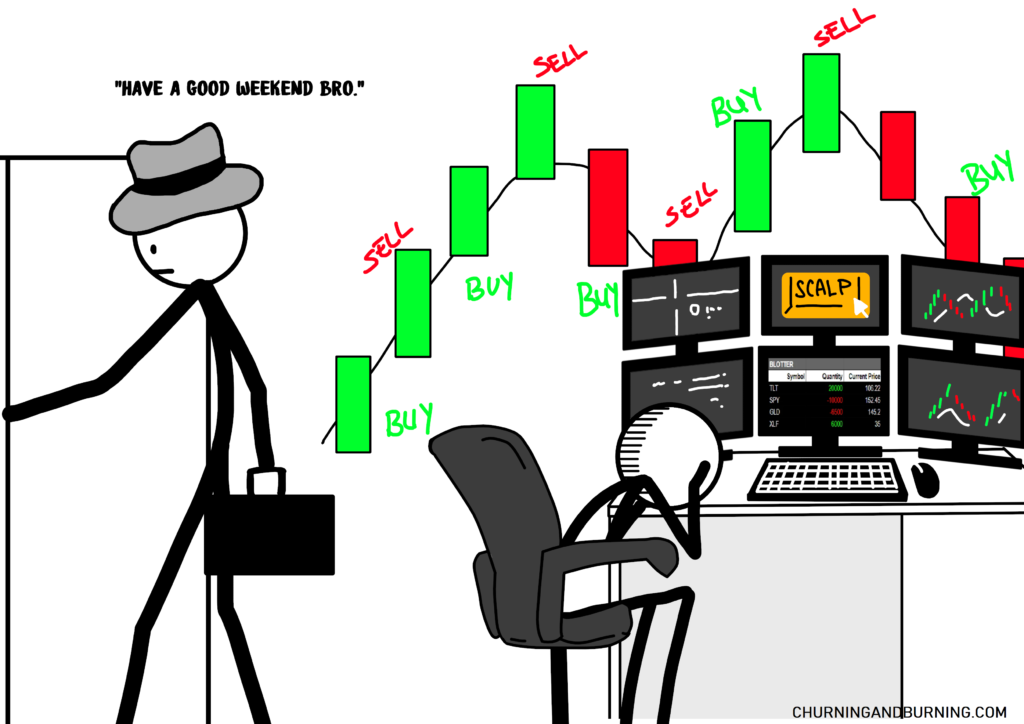
Soup was a new member of the NYC branch, another ringer hired after the start of the Joint Venture. He spent 15 years in traditional finance, mostly equity research. He would show up once a month to make a trade. It went something like this:
End of the current month: Leg into 2 longs and 2 shorts with a VWAP algo (two pairs trades)
Start of the next month: Close all positions. Profit.
That would be it, he’s done. You wouldn’t see Soup again until the end of the month. This made a surprising amount of money.
My theory is that Soup was leveraging his knowledge of “how things work” from traditional finance and front running an institutionally-driven stock pattern—like he found some “poker tell” for Fidelity Total Asia Dividend fund’s month-end executions and he made this edge his entire career. He’s the lazy trader’s ultimate dream.
9. The Number One — Hopeland

Every trading firm worth its salt should have a #1 guy, ideally a homegrown trader, who you could point to and say “Yep. He’s him. He’s special.” That signals that a firm can train a top trader and offer him the deal structure and environment to have him stick around. For WTG, their guy was Hopeland.
He never made the trip to NYC and he never added me on the blotter, so I never met him. I only know the tales.
- During the WTG’s best day ever, the 2010 Flash Crash, Hopeland made $19 million.
- Whenever I talk to traders from other firms, I always ask them who their Number One trader is. Then I ask, what do they trade well? The answer is always “everything”. Hopeland was a top-3 manual trader and also doubled as a top-3 automated trader in the monthly PnL reports. It is rare to be good at both. He traded inefficiencies. He traded directional. He traded special situations. He did it all. In the present day, he now runs his own WTG-backed hedge fund.
- I asked someone behind the scenes at WTG how he would describe Hopeland’s mindset on markets. His words: “Zero Fear. Embodied the phrase ‘not my money’.”
TAKEAWAYS
The Pain-Time Matrix again, this time with the WTG and Joint Venture traders.
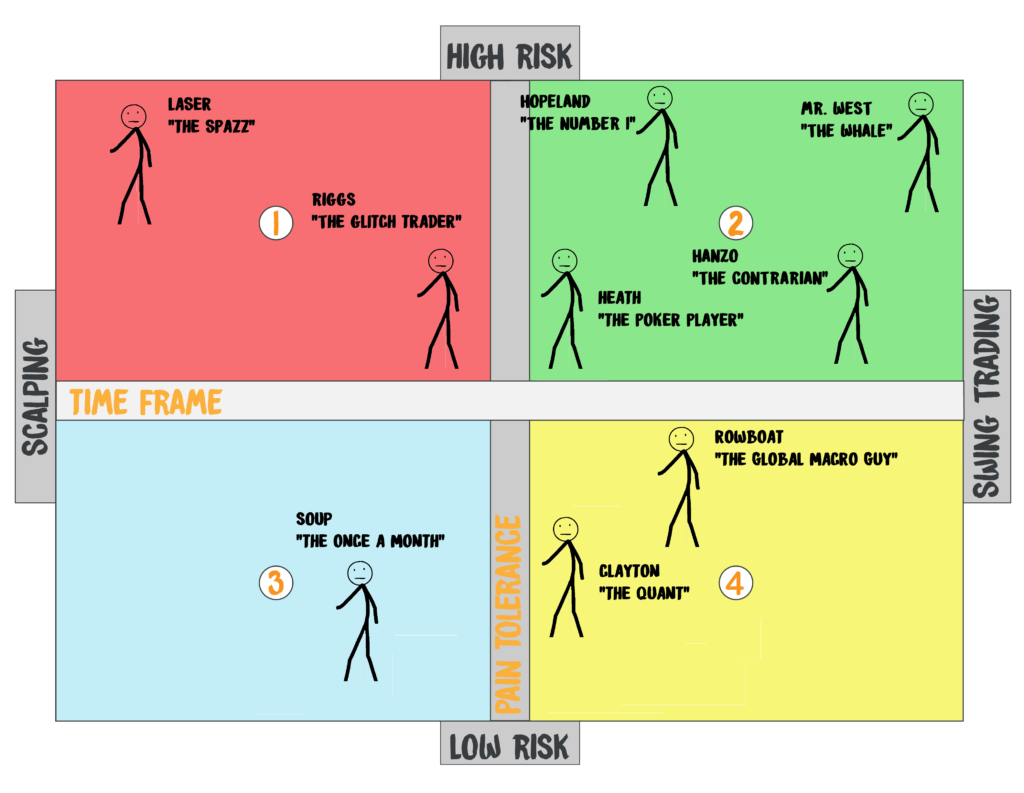
So what can we take away from this? It’s tempting to think: hey, why don’t I just emulate the trader with the highest absolute PnL? It might be an okay place to start but keep expectations in check because that trader’s strategies may not be the strategies for you. Or he may have higher risk tolerance than you do. Here’s my advice to you:
- If you’re just starting out, find as many successful traders as possible, from all different backgrounds, to have in your trading circle. Figure out what people do well, why they’re able to do it well, and try to make their trade your own. It has to make sense to you.
- Once you start to know what you’re doing, narrow down to more like-minded traders with lots of “strategy overlap” to have in your inner circle. These are the guys you talk to about the most important things: your trading system’s core principles and your A+ setups. Everyone else is for emotional support or gossip or laughs, maybe a new idea every now and then.
- Self-awareness is key. Sometimes you start down a path and it’s just way off from the actual best path for you (and only now, after some war scars, can you sense it). You might have developed a circle of discretionary stock scalpers and 3 years later you realize you should have been talking to forex quants. If you think a certain style of trading is a bad fit, then pivot. My friend Mesut never really meshed with the MBC momentum orthodox, but he found his niche under Riggs with special situation driven trading. You can’t win at this game until you find the things you can excel at.
Sorry, I stopped at nine. There’s still one more.
10. The Penny Stock Trader — Me
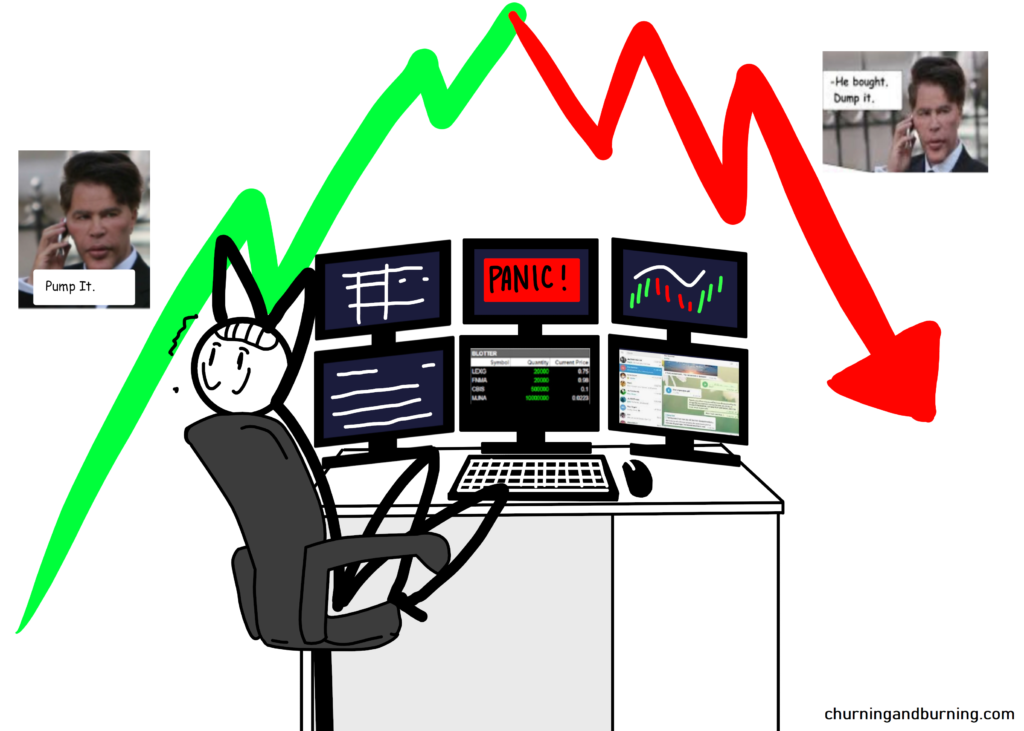
They’re much more popular today but back then, there wasn’t enough volume for prop desks to trade micro-cap actively. They were seen as more of a dark art. Before my time at MBC, there was a guy who would just spend his whole day accumulating 20 micro-cap positions. During my first year, there was another guy who would trade sub-$1 biotech’s as his primary strategy. And then a year after I left, there was another guy who tried to corner low float stocks. There’s always one Penny Stock Guy on a desk.
I never tried to be a Penny Stock Guy. I guess that was my base of knowledge that began with my retail account but I joined MBC so I could trade all kinds of stocks and strategies. I wanted to be an imbalance crusher just like Riggs. I wanted to hero buy market capitulations just like Hopeland. The majority of my daily volume was still on mid/large-cap stocks. But as 2013 unfolded, I had to be the guy on the desk who would assume the mantle of Penny Stock Guy. Why? Because in late May, Fannie Mae is going parabolic… AGAIN.

And I know exactly what it is going to happen next.
(to be continued in Fannie Mae)

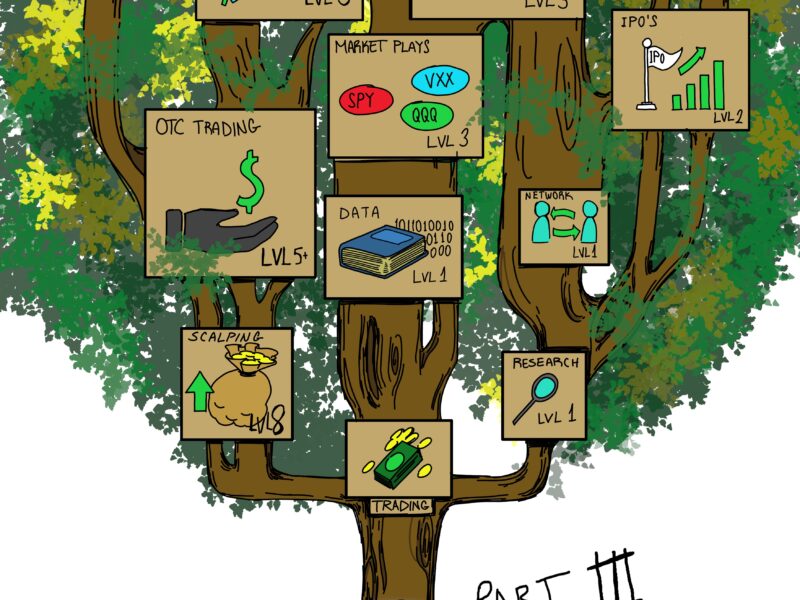


Fun read, Peter!
Best regards from Norway.
John
Love your writing and insight into the prop/trading world. Keep going!
Thank you, please come back for more good content 🙂
One of your best posts yet, loved it!
Just read everything in one push such a good and fun read and some great insights!
Among all these mentioned types of traders, the last type or stage of a trader’s development is missing. A professional at the final stage of their development pays special attention to risk minimization and holding a profitable position within 1-3 minutes after opening a trade.
Fair points made!
Very entertaining read and great writing! I used to work at this place and know almost all these people. Keep it up!
Glad you liked it! I think we met once. Assuming you’re the “Andy” I have in mind.